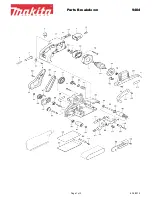
English
8
(original instructions)
Features
This tool includes some or all of the following features.
1. Handle
2. On/off button
3. Sanding pad
4. Battery
5.
Dust canister
6. Charger
Charging procedure (Fig. A)
BLACK+DECKER chargers are designed to charge
BLACK+DECKER battery packs.
● Plug the charger (6) into an appropriate outlet before
inserting the battery pack (4).
● Insert the battery pack (4) into the charger (6) as shown
in figure A.
● The green LED (6a) will flash indicating that the battery is
being charged.
● The completion of charge is indicated by the green
LED (6a) remaining on continuously. The pack is
fully charged and may be used at this time or left on
the charger.
Note: Recharge discharged batteries as soon as possible
after use or battery life may be greatly diminished. For longest
battery life, do not discharge batteries fully.
It is recommended that the batteries be recharged after
each use.
Leaving the battery in the charger
The charger (6) and battery pack (4) can be left connected
with the LED glowing indefinitely. The charger will keep the
battery pack fresh and fully charged.
Important charging notes
● Longest life and best performance can be obtained if
the battery pack is charged when the air temperature is
between 65°F and 75°F (18°- 24°C). DO NOT charge the
battery pack in an air temperature below +40°F (+4.5°C),
or above +105°F (+40.5°C). This is important and will
prevent serious damage to the battery pack.
● The charger and battery pack may become warm to touch
while charging. This is a normal condition, and does not
indicate a problem. To facilitate the cooling of the battery
pack after use, avoid placing the charger or battery pack
in a warm environment such as in a metal shed, or an
uninsulated trailer.
● If the battery pack does not charge properly:
u
Check current at receptacle by plugging in a lamp or
other appliance.
u
Check to see if receptacle is connected to a light switch
which turns power off when you turn out the lights.
u
Move charger and battery pack to a location where the
surrounding air temperature is approximately 65°F
- 75°F (18°- 24°C).
u
If charging problems persist, take the tool, battery pack
and charger to your local service center.
● The battery pack should be recharged when it fails to
produce sufficient power on jobs which were easily done
previously. DO NOT CONTINUE to use under these
conditions. Follow the charging procedure.
You may also charge a partially used pack whenever you
desire with no adverse affect on the battery pack.
● Foreign materials of a conductive nature such as, but
not limited to, steel wool, aluminium foil, or any buildup
of metallic particles should be kept away from charger
cavities. Always unplug the charger from the power
supply when there is no battery pack in the cavity. Unplug
charger before attempting to clean.
● Do not freeze or immerse charger in water or any
other liquid.
@
Warning! Do not allow any liquid to get inside
charger. Never attempt to open the battery pack
for any reason. If the plastic housing of the battery
pack breaks or cracks, return to a service center
for recycling.
Charger Diagnostics (Fig.B)
Refer to the indicators in figure B for the charge status of the
battery pack.
Bad Battery
If you see a bad battery blink pattern, do not continue
to charge this battery. Return it to a service center or a
collection site for recycling.
Hot/Cold Pack Delay
When the charger detects a battery pack that is too hot
or too cold, it automatically starts a Hot/Cold Pack Delay,
suspending charging until the battery pack has reached an
appropriate temperature. The charger then automatically
switches to the pack charging mode. This feature ensures
maximum battery pack life. A cold battery pack will charge at a
slower rate than a warm battery pack. The pack will charge at
that slower rate throughout the entire charging cycle and will
not return to maximum charge rate even if the pack warms.
Installing and removing the battery pack from
the tool
To install battery pack Fig. C)
● Insert battery (4) into tool until an audible click is heard
(Figure. C)
● Ensure battery pack is fully seated and fully latched
into position.
To remove battery pack (Fig.D)
● Depress the battery release button (7) as shown in
figure D and pull battery pack (4) out of the tool.
Attaching hook and loop sanding discs (fig. E)
For best results, use BLACK+DECKER accessories.
● Your sander is designed for use with either mesh carbide
sandpaper or with standard sand paper with the 8 hole
dust extraction pattern.
● To attach the sanding disc (8), carefully center it over the
sanding pad (3) ensuring the holes in the disc align with
the holes in the pad and press the disc firmly in place.









































